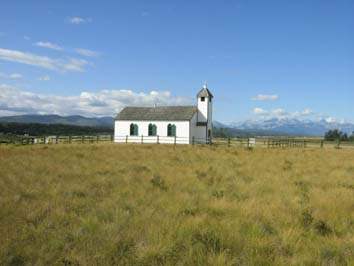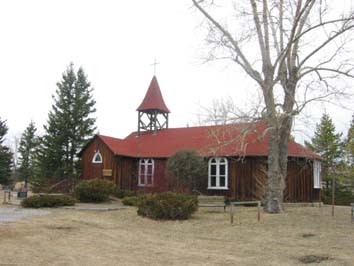
a solo exhibition by Simon Wroot
Three Churches still in use.
Eagle Butte
St. Margaret’s Church, 1907
|
|
Canon George McKay held services in Ft. Walsh to the east in 1878, and regular services were then held in the Cypress Hills from 1883 onwards. Land for a church was donated by a local family, as were time and material from other settlers in the area. St. Margaret’s Church was built in 1907-08, and opened by the Bishop on June 28. A prominent family, the Musgroves, lost their 12 year old daughter Margaret, so the church was named in her honour. Services were held mainly in the summer with clergy coming out from Irvine, and later from Medicine Hat. In the early ‘40s the local school-house was ‘torched’ not once but twice by a disgruntled rancher, so the church was used as a school house. It must have been very cold as there was neither insulation or electricity. The last regular services were held by Archdeacon J.W.Carter in 1969. In 1976 the Diocese sold the property to the Very Rev’d D. Carter. There were work parties held each July 1 weekend to maintain the church and cemetery. In 1992 a complete renovation took place, insulation and electricity were installed. The original font was located, the altar is from an abandoned church at Coutts, the alter cross from Grassy Lake, the lectern from the Orion area, and the stove from Milk River. It is now operated on a non-denominational basis with services being held 4 times a year: Easter, harvest, before Christmas, and as close to June 28th as possible. It is administered by a non-profit society.
All of the renovations were done by local volunteers, as is the continuing maintenance of the church and cemetery. This beautiful little church continues to enthral and inspire it’s ever increasing congregation of admirers, and is a living memorial to all those who settled and worshipped.
Morley
McDougall Memorial United, 1875
|
|
Generally known as the Old Morley Church, to the Stoney it is their church, built for them by the Rev. George McDougall. This was the first Protestant church in Southern Alberta. After several visits with the Mountain Stoneys on the Bow, Rev. McDougall returned with sanction from the Methodist Church to establish a mission at Morley. A rough structure was built in 1873 a few miles NW of the current site. With willing help from the Stoneys the previously whip-sawn logs and the lumber from Sibbalds mill, the buildings soon went up and the church was opened in 1875. Unfortunately, in the winter George was part of a hunting party, and became separated from the rest in a blizzard. After 2 weeks of searching his frozen body was found near Nose Creek, not far from Calgary. He was buried in the Indian burial ground north of the church. His brother John continued his work. In 1888 the area was surveyed and the Church lands were set aside from the reservation formed by Treaty No. 7. When a new church further west was built in 1921, it became abandoned, and withstood wind, weather and vandals. Restoration was started in 1950, but began in ernest in 1957. Since then time and effort have have been cheerfully donated by skilled and unskilled volunteers to restore and maintain this landmark in serviceable condition. The Stoneys also cut & peeled the logs for the fences, dug post holes, and did a myriad of other tasks that honour the church, the people who built it, and who serve it. Since 1952 there have been numerous Sunday services, and the church is open to visitors during the summer weeks. Standing foursquare between the prairie and the mountains it has withstood time, the elements, and changes in our society. It is a true landmark in the area, and a landmark for Alberta as an example of cooperation between peoples, regardless of creed or race.
Millarville
Christ Church Anglican, 1886
|
|
The Rev. R. Murray Webb-Peplow cane to Millarville from England in 1894 to ranch. Recognising the need for an Anglican Church, a decision to build was made in Oct of 1895. Land was donated by the Rev., and in 1896 Christchurch was constructed , with opening ceremonies on May 6th. Rev. Webb-Peploe was primarily responsible for the unique construction of the church; it is built of spruce logs placed in an upright position. Local residents were worried that this construction would not withstand the strong winds, and the contractor agreed to not accept payment until the building had been standing for 3 months. In 1926 it was discovered that the logs that had been left un-peeled were being destroyed by wood boring insects. The parishioners quickly peeled the logs and covered them with a preservative. The work of the insects is visible today in the form of exquisite tracings covering the log’s surface. In 1920 a portion of the church grounds was consecrated as a cemetery, and a war memorial was erected. The bell was donated by the Hudson’ Bay Company, after it was discovered in the Alexander Corner building in Calgary during the construction of the new HBC. Christ Church has it’s own brand, M26, and each fall a number of calves are donated to receive this brand, and the donors raise them to be sold the following year. The money raised goes to the maintenance and operation of the church. The landscaping of the grounds was envisioned by the artist Jon Lowry, and was constructed and is still maintained by the Millarville Horticultural Club. This unique little church has the privilege of being one of very few that has been lucky enough to have a thriving and committed parish, who still give their time and energy to see that their church flourishes.


